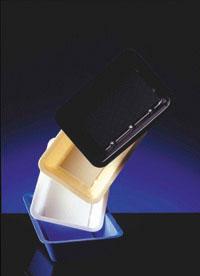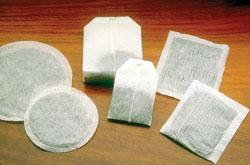 |
| McAirlaid’s SuperCore technology
is the first commercial airlaid made for food pads without latex
or synthetic binders. |
Nearly five years ago, as optimism
for the future of airlaid reached its high water mark, several companies
were predicting that its increased capacity would lead to new applications.
Currently, a much different reality exists, and the landscape for
airlaid application is more a vast, mysterious tract than the land
of milk and honey.
Companies such as Concert, Buckeye and BBA Fiberweb were the major
contributors to this airlaid expansion which was driven for use
in medical, diaper and wipes applications. Yet, when these markets
failed to explode as anticipated, all was not lost and food packaging
emerged as a ripe new application for airlaid. Some industry experts
estimate that the use of airlaid in food packaging has increased
ten times since 2000, most notably in the application of meat trays
and absorbent meat pads, a market previously dominated by multiply
laminated tissue.
In the past five years, the Food and Drug Administration’s
approval of certain superabsorbents in both granular and fibrous
form for indirect food contact has provided an excellent opportunity
for airlaid manufacturers. Airlaid technology now represents an
ideal vehicle for efficient use of superabsorbents in food packaging
and a variety of new product formats have been designed for this
growing market. A recent study conducted by The Freedonia Group,
Inc., a Cleveland-based industrial market research firm, forecasts
that “...U.S. foodservice packaging demand should climb 4%
per year to $7.6 billion in 2008.” This growth is not limited
to airlaid, but the material consistently takes a larger share of
the the food packaging market every year.
The Door Is Open
Traditional food packaging products have been made for years utilizing
multiple plies of absorbent tissue products that are typically stitch
laminated to a barrier film material. While these products have
served as effective, low cost absorbent pads for poultry and red
meat packaging, there are some significant drawbacks.
The film tends to delaminate from the pad when it is wet, and the
lack of wet strength in the tissue results in an unattractive pulp
mass at the bottom of the tray when the meat is removed. Most significantly,
the tissue product will absorb fluid but has poor retention properties
so fluid can re-emerge into the pack. Recent advances in commercial
technology have prompted a new phase of growth and product diversification.
In the early days of airlaid there were primarily three properties
that airlaid products brought—absorbency, wet strength and
softness. Today, the picture has changed.
The ability of modern airlaid systems to incorporate a broad range
of synthetic fibers and diverse bonding technologies has yielded
a new range of properties, particularly controlled absorption, wet
strength and hydrophobic zones and surfaces as well as the ability
to present the technology in multiple ply structures. These properties
are all attractive to food package manufacturers. Additionally,
airlaid products can provide cost-effective absorbency, which is
the Holy Grail of all interested parties.
The final product is an attractive-looking packaging tray or a meat
pad that retains its integrity when wet and has better fluid retention
properties that together, provide an attractive case-ready package
that satisfies customer demand.
 |
| McAirlaid’s SuperCore is also
found in absorbent meat pads. |
Complex Cycles
Supply and demand issues have most recently hampered extensive growth
of airlaid in the application of food packaging with a number of
complex cycles. Most recently, the availability of superabsorbent
fibers—a component common to airlaid food packages and absorbent
meat pads—is in short supply for this market. While plenty
of airlaid exists worldwide, the type ideal for food pads is limited
due to limited raw material supply. Another factor that dictates
the food packaging market is the price of meat itself. Currently,
with poultry prices at an all-time high, poultry producers have
been able to upgrade the quality of the packaging used to deliver
their products. Yet, when chicken prices are low, producers look
to cut costs by lowering the quality of packaging. Packaging materials
will literally change with the state of the market, forcing cost
sensitivity into the equation. An example of this would be last
year’s chicken flu outbreak in the Netherlands which forced
the EU to immediately adopt a ban on movement of poultry within
the Netherlands and also any export of poultry and eggs from that
country. In the beef industry, the recent infection of mad cow disease
prevented the export of beef from the U.K. and forced the destruction
of hundreds of thousands of cows in that country. Events like these
can cause severe economic damage to the respective industries and
cause heavy fluctuations in pricing. However, Europe is traditionally
a more advanced market for food presentation with the U.K. leading
this trend. Within nonwovens airlaid is the dominant material used
for food packaging and as becoming more predominant in U.S. food
packaging.
 |
| Ahlstrom is making inroads in food
packaging with the use of wetlaid technology. |
Technology Beckons
Advances in technology is matching changes in food packaging trends.
No longer a niche, airlaid food pads are becoming a viable market
that is vulnerable to technological changes in packaging. Literally,
the way meat is sold drives food packaging development. Food packaging
producers say their customers are looking for a high degree of absorbency,
controlling the liquid that is secreted from the meat. As always
cost and wet strength-- problems associated with earlier tissue
pads, are important considerations.
Steinfurt, Germany-based McAirlaids has focused on technology in
meat packaging with its current offering, SuperCore. The first commercial
airlaid food packaging material without latex or synthetic bonding
fibers, SuperCore uses a proprietary patented thermo-mechanical
bonding process. The flexibility of its production process enables
McAirlaid clients to tailor make SuperCore to the individual needs
and requirement of its customers. “Currently, the economic
situation in Europe is on a downturn, due to governmental and economic
restructuring. But, the introduction of our new product should keep
us ahead of the competition,” said Alex Maximov, managing
director of McAirlaids.
 |
| Ahlstrom’s wetlaid technology is already used in products
such as tea bags and coffee filters. |
Airlaid Alternatives
Recognizing the potential for growth in food packaging markets Ahlstrom,
Windsor Locks, CT, is making a play with its offerings of absorbent
food packaging applications in wetlaid technology. Ahlstrom’s
initiative is banking on what it claims is wetlaid’s ability
to process more efficiently than airlaid in the production of food
pads.
“Wetlaid is the company’s core technology, and we have
been successful with wetlaid in other market segments in food packaging,”
said Brian Koscher, director of marketing for meat packaging products
at Ahlstrom. “We are the market leader in the reinforcement
substrate used in fibrous meat casings, so what we have commercially
available, what we are using today, is what we at Ahlstrom are using
to increase our sales by expanding into new categories of food packaging
by starting with what we know best.” Mr. Koscher said his
company recognizes there are an ample number of airlaid suppliers
active in the food packaging industry, but feels that Ahlstrom’s
flexibility with wetlaid technology can take advantage of his customer’s
desire for differentiation in the form of more colorful finished
product’s functionality, and potential additional features
such as anti-microbial treatments found in its products.
“If you establish yourself as a value-added supplier, you
certainly can earn pricing to meet your objective,” he said.
Staying The Course
Since experts in the food industry say package leaking is a huge
complaint among customers, superabsorbency will increase airlaid’s
potential for incremental growth in meat packaging. However, this
growth hinges on its ability for constant improvement of product
offerings. Increased competition among end users and alternative
technologies, such as wetlaid, can only cause further development.
Food packaging experts claim those in the game are converting to
airlaid due to customer demand for a premium product, thus, development
and upgrading is bound to happen.
|

